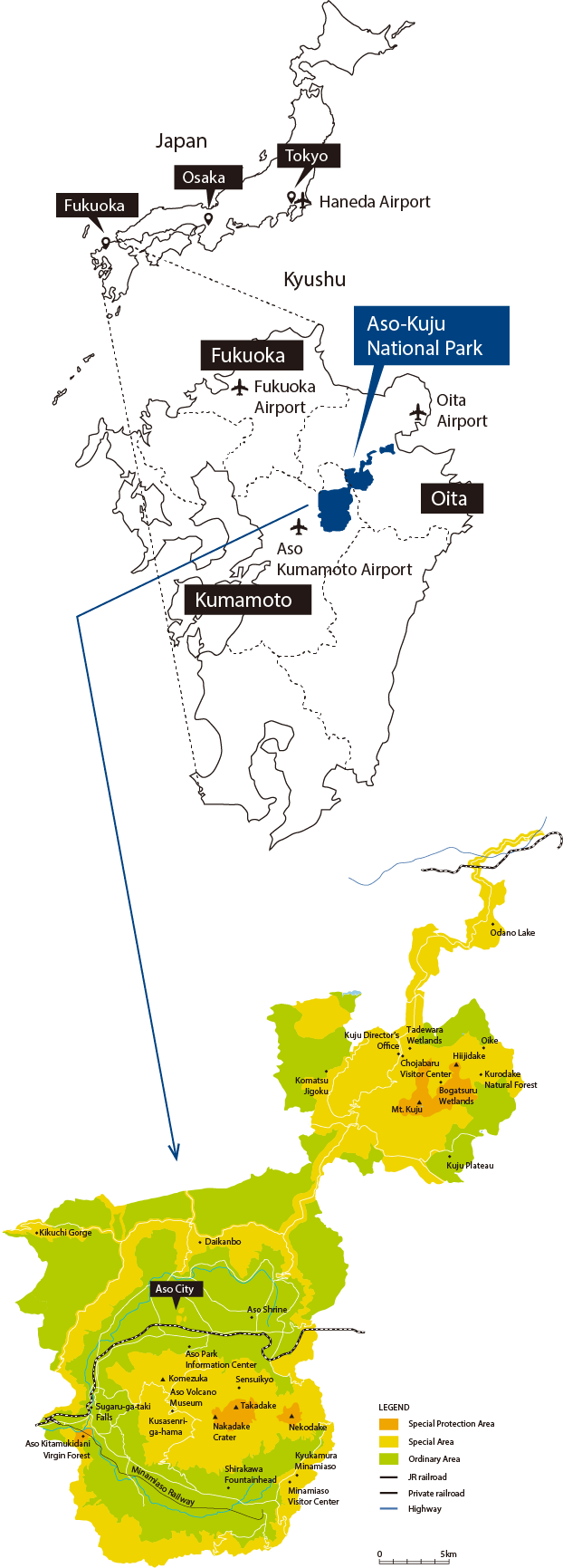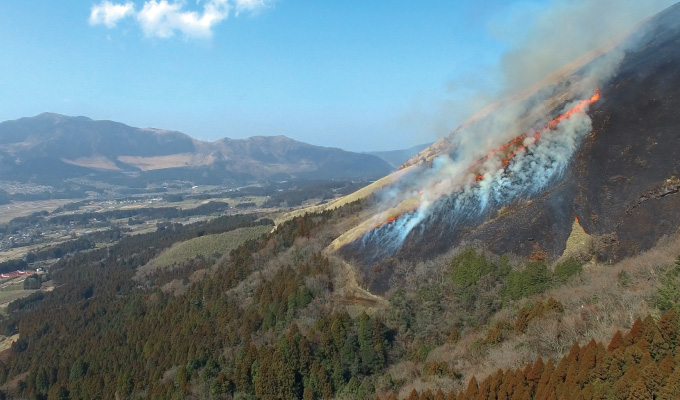
GRASSLANDS
rebirth through fire
The grasslands of Aso exist as the result of enormous volcanic activity that occurred long ago coupled with careful conservation and maintenance by the locals that began over 1,000 years in the past and still continues to this day. These grasslands thus represent a connection between man and nature that has lasted for centuries.
Aso has a highly varied landscape, with steep craggy peaks in some areas and perfectly flat plains and rolling hills in others. This is all due to volcanic activity that occurred from 270,000 to 90,000 years ago, creating the cavernous Aso Caldera.
If no one did anything, open land in this area would be overrun with bushes and trees, eventually turning into dense woodland. Early settlers in the area likely maintained the grasslands through noyaki (controlled burns of the grasslands), thereby preventing tree growth and allowing locals to use the grasslands for farming and raising cattle.
The Aso grasslands are first mentioned in the Kojiki, a book written 1,300 years ago. This means local residents were already maintaining the grasslands since at least the 8th century. For hundreds of years, the locals have protected the grasslands as part of their livelihood.
As Japan’s population decreases and lifestyles change, the size of the grassland that can be maintained is getting smaller and smaller each year. It takes the hard work of many people to maintain these grasslands, and the locals are currently trying new methods to help save them.
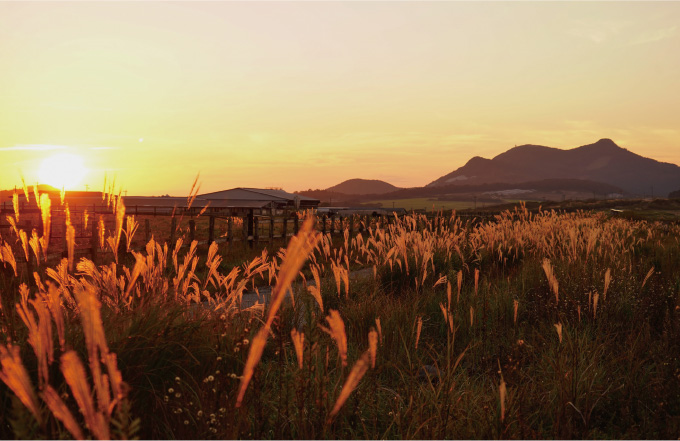
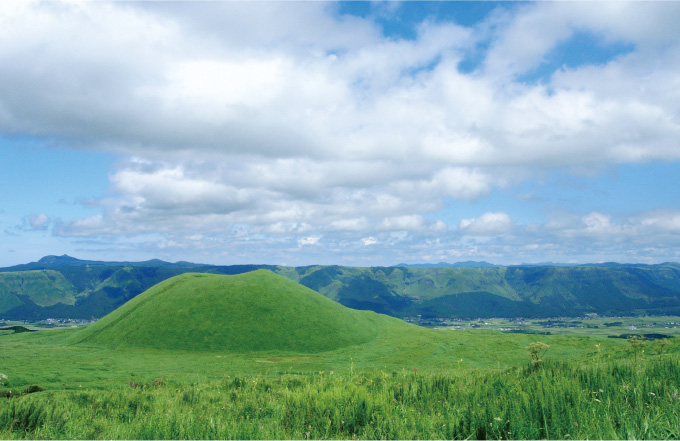
The grasslands change dramatically with the seasons, from bright emerald green in the spring to the silvery beige of the pampas grasses in the fall.
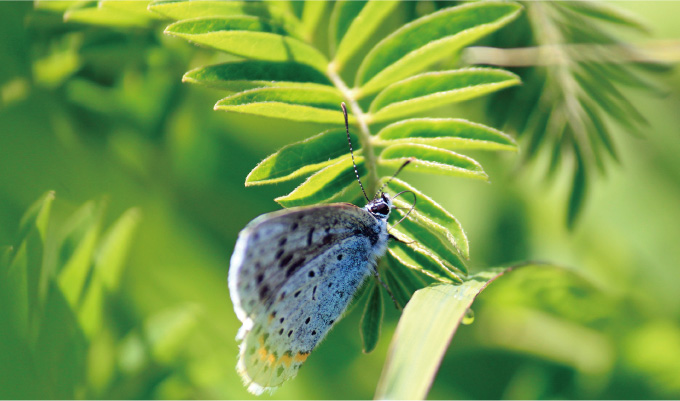
BIODIVERSITY
The grasslands support a highly diverse ecosystem that is home to many unique and rare insects, plants, and animals. Some, like the Orurishijimi butterfly shown here, are on the Endangered Species List.
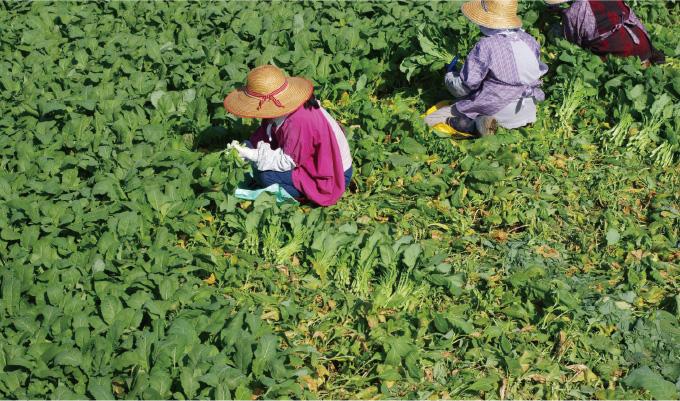
FARMING & RANCHING
Aso soil contains volcanic ash and is not always suitable for farming, yet farmers adapt by growing produce capable of growing in volcanic soil, like takana (mustard greens) and tsurunoko imo (small potatoes). Farmers also mix compost with the soil to make it more fertile.
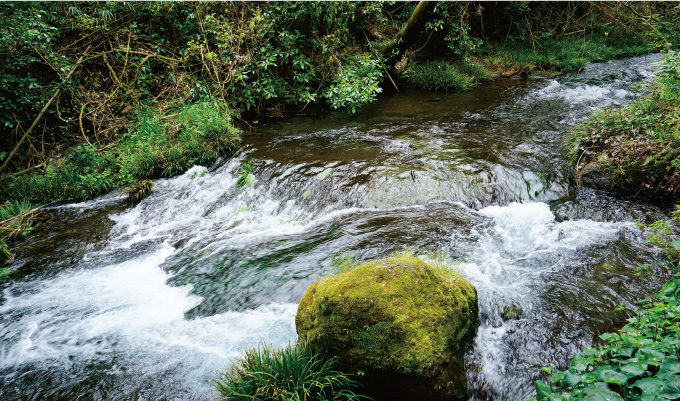
RAINWATER MANAGEMENT
Over 2,500 millimeters of rain fall on the Aso grasslands per year, almost twice that of Tokyo. This rainwater, combined with an abundance of springs, serves as the source for many of Kyushu's major rivers, which in turn irrigate farmland and provide water to residents all over Kyushu.
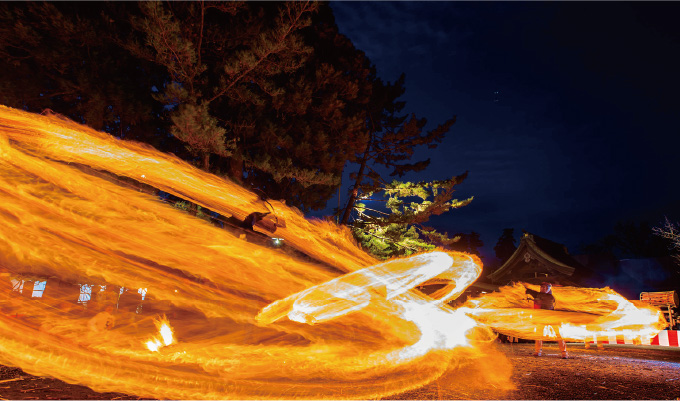
CULTURE
Over a thousand years of living in harmony with the grasslands and the fiery Aso volcano has created a culture unique to the region and closely tied to the land. In this photo, participants swing burning bales of hay in the Hifuri Shinji Festival at Aso Shrine.
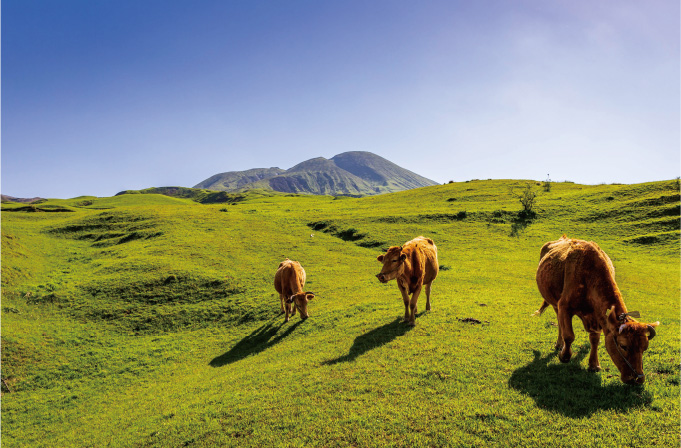
A HISTORY
at risk
A centuries-old local tradition with an uncertain future
Historically, the grasslands acted as pastures for horses and cattle that were used to work the farmlands of Aso. Locals also harvested the grasses to build thatched roofs and to use as fuel, thereby forming an integral part of life in Aso.
Keeping these grasslands from reverting to woodland is a year-round responsibility. The grasslands cover 220 square kilometers (over twice the area of Paris!) so many people are needed to keep the grasslands healthy and beautiful.
Nowadays, however, lifestyles are changing so fewer people rely on what the grasslands provide. The work animals that once grazed on the grasses have been replaced by tractors and machines. There are also fewer people living in the Japanese countryside, so in the end the number of people ready and willing to work on the grasslands is decreasing. The result of this is that the entire area of the grasslands has shrunk to less than half the area it was 100 years ago, and this area still continues to shrink.
Shrinking grasslands
The maps below show how much of the grasslands have been lost over the past century. Light green areas are grasslands and dark green are woodlands.

Around 1900
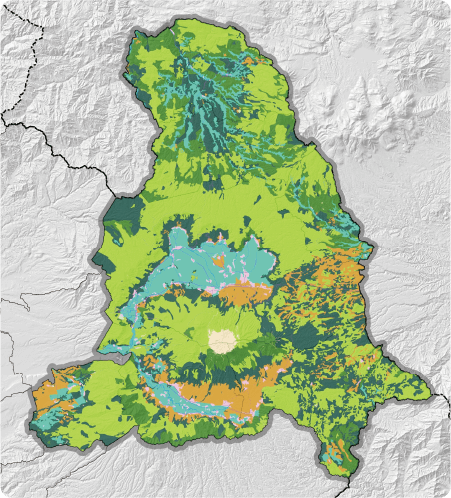
Around 1950
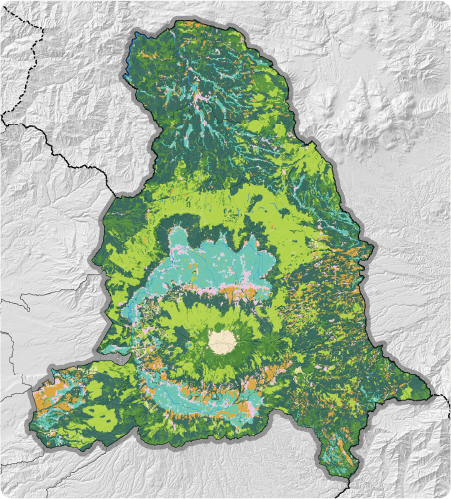
Around 2000
* Images courtesy of the Aso World Heritage Promotion Office
How we use the grasslands
In addition to contributing to a beautiful landscape, the grasslands are vital to local culture, agriculture, and business. Here are a few of the ways Aso residents utilize the grasslands.
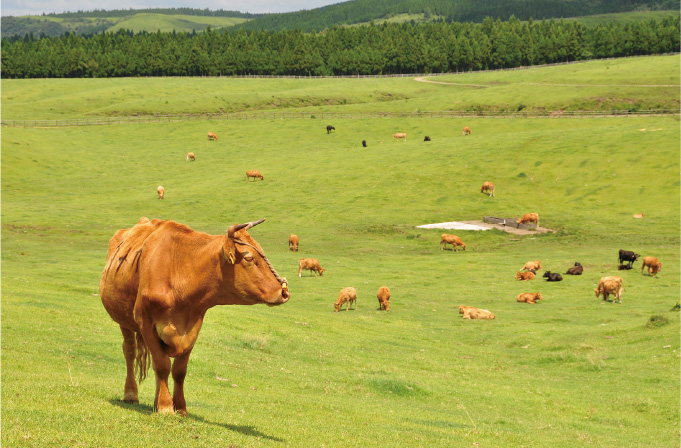
CATTLE GRAZING
Cattle are sent out to pasture each year from April to December and brought inside during the winter months when the grass has died out.
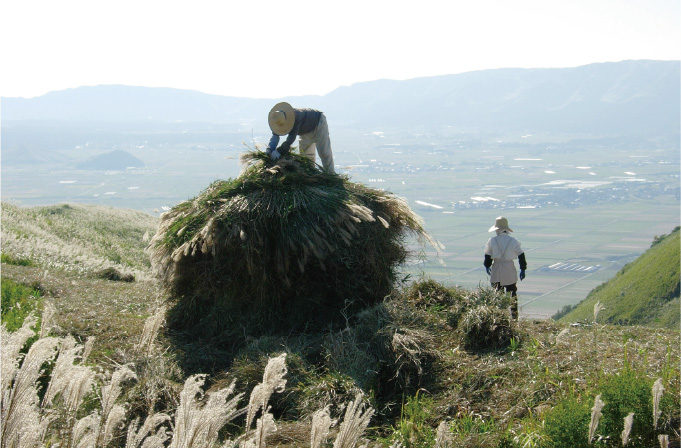
GRASS HARVESTING
Before the grass dies off for the year, ranchers harvest the nutritious grasses and dry them in the sun for a few days before storing them for use as cattle feed in the winter.

COMPOSTING
Grass not used to feed animals can be composted to turn it into soil full of nutrients that can then be used to help grow crops.

THATCH HARVESTING
Many historical buildings in Japan have roofs made from dried grasses. There is business potential for growing grass for roofing.

YOU CAN HELP
save the grasslands
A culture and landscape at risk of disappearing
As more and more untended grassland areas turn to woodland, local groups are working to develop programs to increase awareness of grassland preservation efforts. Volunteers have played a big part in reviving the grasslands through participation in noyaki, wachigiri, grass harvesting, and wildlife protection projects.
New business ventures are also being explored that are both profitable and beneficial to the grasslands. Tour guides are also being trained to give tours around Aso, and a portion of the proceeds is then donated to saving the grasslands. Others are looking for new uses for harvested grasses, like in building and repairing thatch roofing and in composting.
There’s also plenty that visitors to Aso can do to help. The simplest way is to donate. Over 150 donation boxes are located throughout Japan, so if you see one, feel free to toss in some change to help the cause. If you live in Japan, you can also pay to own an Akaushi wagyu cow that you can name and receive regular shipments of local Aso produce in return. Another easy way to support the grasslands is to buy items produced in Aso. So while you’re here, be sure to try some excellent Akaushi wagyu and pick up some locally produced souvenirs to take back home with you!
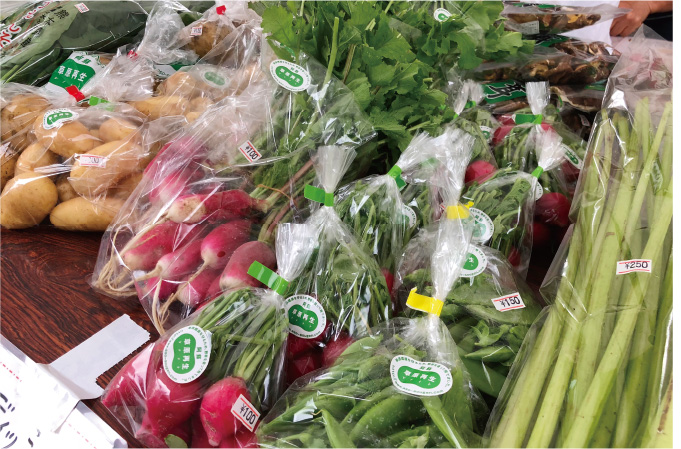
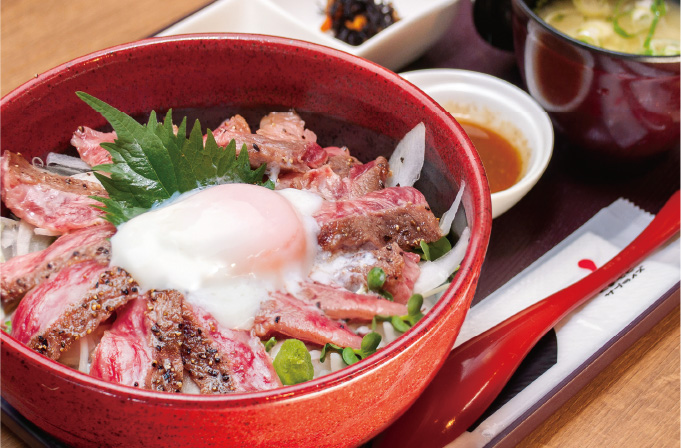
Come visit Aso and enjoy some of Aso's great local produce and famous Akaushi wagyu beef.
Keys to restoring the grasslands

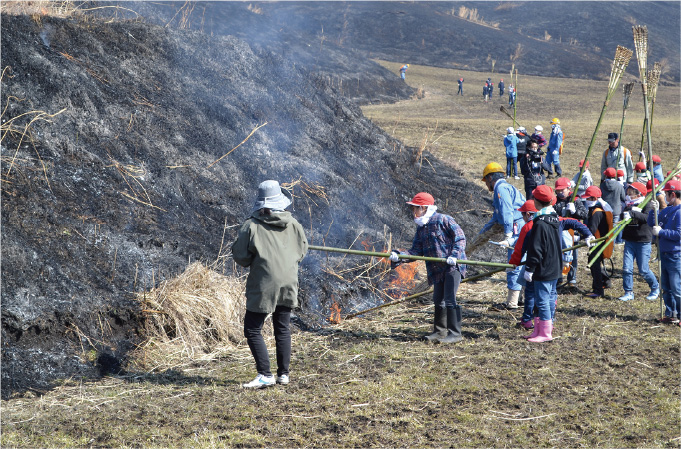
EDUCATION
Educating future generations about the importance of the grasslands is essential in their preservation. Workshops, activities, and exhibits are held for children and locals to educate and get people involved in preserving the grasslands.

NOYAKI
Noyaki controlled burns, held every year around March, are performed with great care to ensure the safety of all involved. Noyaki in Aso is unique in that it is done to keep shrubs and trees from overtaking the grassland, to kill pests, and to encourage new grass growth. Aso noyaki is also unique in that it is done for wetlands as well. Soon afer the burns are complete, new grasses and flowers sprout through the ground and turn the landscape green again.
Noyaki also helps the environment. Grass removes CO2 from the air and converts it into the carbon compounds it needs to live and grow. Burning this grass turns these carbon compounds into charcoal, which enters the soil and stays there. This effectively removes CO2—a greenhouse gas—from the atmosphere and traps it in the soil.
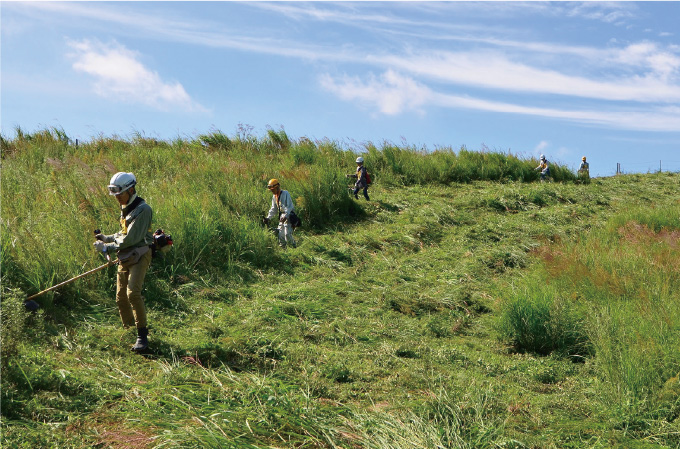
WACHIGIRI
Wachigiri is the cutting of firebreaks (long narrow lanes through the grass) by hand to control what areas are burned during the noyaki controlled burns. Wachigiri is very important in preventing fire from spreading to unwanted areas. As this needs to be done every year, organizers are exploring the option of creating permanent firebreaks.
About the National Parks of Japan
National Parks in Japan are natural scenic locations that have been selected by the national government to represent the nation of Japan. From Hokkaido in the north to Okinawa in the south, there are a total of 33 National Parks in Japan that welcome a total of over 300 million visitors annually.
Each National Park of Japan features not only breathtaking landscapes, but diverse wildlife and interesting histories and culture. Japanese National Parks are unique from other national park systems in that Japanese National Parks can sometimes include entire towns and cities, letting visitors experience both the great unspoiled outdoors of Japan while also learning about the history and culture of the locals, all in the same park.
About Aso-Kuju National Park
Designated as a National Park of Japan in 1934, Aso-Kuju is one of Japan’s oldest National Parks and is centered around the volcanic formations of the Aso Caldera and Kuju Mountain Range. The park boundaries include all or part of five cities, six towns, and two villages in the prefectures of Kumamoto and Oita and is located in the middle of Kyushu, the southernmost of Japan's four main islands.
The park was heavily affected by the 2016 Kumamoto Earthquakes, but construction is underway to repair and improve road and railway access within and around the park. Due to frequent road construction and road reopenings, please check your travel routes in advance to make sure the roads you intend to use are accessible.
GETTING HERE
Oita Airport
- Bus (1hr)
- JR Yufuin Station
(Yufuin Station Bus Center) - Bus (50min)
- Kuju Tozanguchi (Chojabaru)
(Closest bus stop to Chojabaru Visitor Center)
Fukuoka Airport
- Bus (2.5hr)
- Oguni (transfer)
- Bus (1hr 40min)
- Aso Roadside Station
Fukuoka Airport
- Bus (4.5hr)
- Senomoto
- Bus (1hr 10min)
- Yufuin Station
Aso Kumamoto Airport
- Bus (45min)
- Aso Roadside Station
These are sample access routes. Please check the Internet for further information. Times are approximate.
